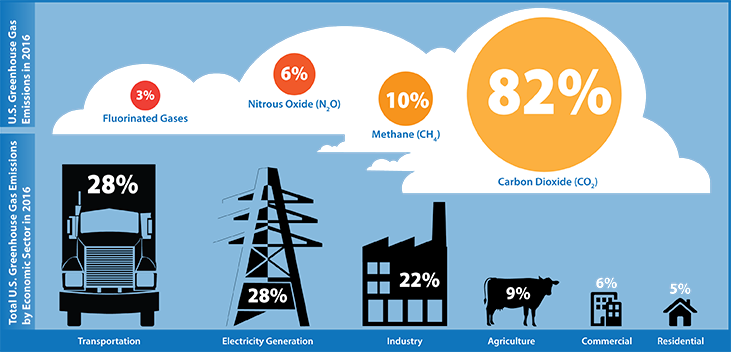Climate Change
As carbon and other greenhouse gas (GHG) emissions have increased dramatically in the past few decades, the threat of climate change has also grown. Solar energy is a renewable, carbon-free resource available in every geographic region of the U.S., with enormous potential to reduce our nation’s GHG emissions. Any market or policy proposal to address climate change should include significant development of solar and other clean energy technologies to power a clean, affordable economic future.
Quick Facts
- The electric power sector is among the largest contributors of greenhouse gases in the United States, representing 28% of all emissions.
- Both concentrating solar power (CSP) and photovoltaic (PV) technologies produce clean, emissions-free electricity that can help reduce U.S. GHG emissions
- Solar heating and cooling systems can provide about 80% of the energy used for space heating and water heating needs.
Sources of GHG Emissions in the United States by Sector
Overview
Scientists agree that climate change is caused by an increase of GHG emissions in the atmosphere. GHG emissions in the United States come from a variety of different economic sectors, with the most prominent sectors being the electric power (28%) and transportation (28%) sectors, followed by industry (22%), commercial and residential consumption (11%) and agriculture (9%).1
There is no one technology that can reduce all U.S. GHG emissions to zero, and SEIA works alongside partners in other industries such as wind and energy storage to advocate for a broad transition to a clean energy economy. Solar technologies are a crucial component of our nationwide effort to curb emissions and achieve ambitious climate goals. Solar energy is not just a solution that can help mitigate our impact on the climate, it also contributes to the resilience and reliability of our electric grid, making America more energy secure in the face of increased natural disasters and powerful storms that become more frequent in a changing climate.
Electric Sector
More than a third of U.S. GHG emissions result from the burning of fossil fuels for electricity usage in buildings and homes. Both Concentrating Solar Power (CSP) and Photovoltaic (PV) technologies produce clean, emissions-free electricity and can feed this electricity directly into the U.S. grid. Solar Heating and Cooling (SHC) technologies can also be used to displace the need for electricity. Through 2022, the U.S. now has more than 142 gigawatts (GW) of cumulative installed solar electric capacity, enough to power more than 25 million average American homes, and offset more than 161 million metric tons of carbon dioxide emissions.2
 Transportation Sector
Transportation Sector
Electric vehicles (EVs) and plug-in hybrids are widely seen as one of the near-term climate change solutions in the transportation sector, especially when these vehicles are charged by a solar-powered carport or charging station. EVs are an increasingly important component of distributed solar power, helping American families reduce their carbon footprint by creating an end-to-end system that includes rooftop solar, home battery storage, and electric vehicles.
Industrial Sector
The U.S. is a highly industrialized country, and therefore a large portion of our GHG emissions stem from the industrial sector. The manufacturing of common materials such as aluminum and steel are energy intensive and generate high levels of GHG emissions. One of the main uses for energy in the industrial sector is for boiler fuel, meaning that energy is needed to generate steam or heat water, which is then transferred to a boiler vessel. Another use for solar energy is for process heating, when energy is directly used to raise the temperature in a manufacturing process, such as in drying paint in the automobile industry, and cooking packaged foods.3 Solar energy can offset the need for fossil fuels by generating high-temperature and medium-temperature heat from CSP and SHC technologies.
 Commercial and Residential Sectors
Commercial and Residential Sectors
The commercial sector includes buildings such as offices, malls, warehouses, schools, restaurants, and hospitals, while the residential sector consists of homes and apartments. Both commercial and residential buildings spend the majority of the energy consumed on space heating, space cooling, and water heating. This is a perfect application for SHC technologies, as the SHC systems can provide about 80% of the energy used for space heating and water heating needs. Furthermore, solar air conditioning can be used as a clean, emissions-free solution to meet cooling needs instead of using electricity. Solar PV is a favored form of electricity for many leading businesses and corporations, who are powering their warehouses, headquarters, and distribution centers with large rooftop systems or off-site solar power plants.
Life-Cycle Assessment
Solar produces less life-cycle GHG emissions than conventional fossil fuel energy sources.4 While there may be some GHG emissions produced during the manufacturing and recycling of the solar system, the generation of energy results in zero GHG emissions and zero environmental impact.
Domestic Policy
SEIA supports comprehensive climate and energy legislation, and is opposed to any legislation that would weaken the Clean Air Act. There are several domestic policy priorities, including tax policy, workforce development and infrastructure, that SEIA members are engaged on to encourage deployment of low-cost solar energy in the U.S.
Other Helpful Resources
- Intergovernmental Panel on Climate Change - International scientific body that compiles data for the assessment of climage change, including environmental, social, and economic impacts.
- Greenhouse Gas Reporting Program - A program run through the EPA in response to the Mandatory Reporting of Greenhouse Gases Rule (74 FR 56260) which requires reporting of ghg data and other relevant information from large sources and suppliers in the U.S. to inform future policy decisions.
- Greenhouse Gas Data from UNFCCC - data from countries around the world.
References
1U.S. EPA Greenhouse Gas Inventory Report. Accessible here: https://www.epa.gov/ghgemissions/inventory-us-greenhouse-gas-emissions-and-sinks
2 U.S. Solar Market Insight Report Report. Accessible here: http://www.seia.org/smi
3http://www.eia.gov/energyexplained/index.cfm?page=us_energy_industry

